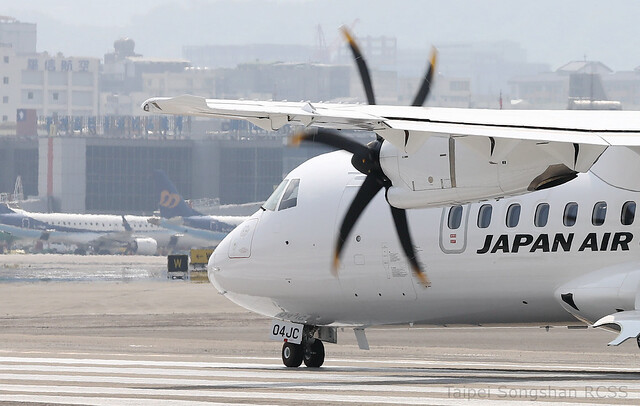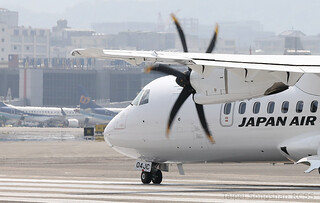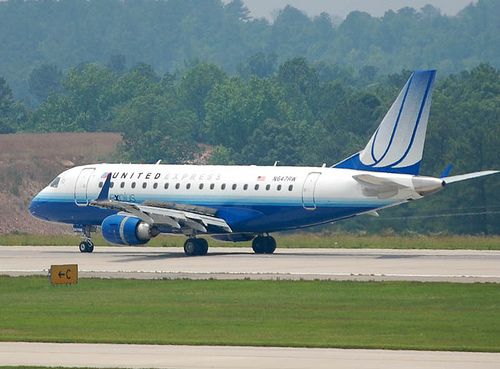JAC AT42 at Amami on Jan 8th 2020, runway excursion on landing
Last Update: April 14, 2022 / 19:51:49 GMT/Zulu time
Incident Facts
Date of incident
Jan 8, 2020
Classification
Incident
Airline
JAC Japan Air Commuter
Flight number
3X-3830
Departure
Kikaima, Japan
Destination
Amami, Japan
Aircraft Registration
JA07JC
Aircraft Type
ATR ATR-42
ICAO Type Designator
AT42
Airport
Amami Airport, Amami
Airport ICAO Code
RJKA
The airport reported there was a strong wind warning in effect, strong gusts were ecountered.
Japan's TSB rated the occurrence a serious incident and opened an investigation.
On Apr 14th 2022 the JTSB released their final report concluding the probable cause of the serious incident was:
The JTSB concludes that the probable cause of this serious incident was the delay in correcting the deviation to the left immediately after the touchdown at landing in a crosswind from the left, which resulted in the Aircraft running off the side of the runway, halting in the grass area and being disabled to move on its own.
The JTSB analysed:
(1) Weather Conditions
The JTSB concludes that it is certain that the weather conditions at the time of occurrence of this serious incident at Amami Airport, although it was under visual meteorological conditions, was such that a northwesterly wind accompanied by a gust was blowing.
(2) Decision on Approach
The JTSB concludes that it is highly probable that the Aircraft conducted the approach and the landing because all crosswind components of reported mean wind velocity by the RADIO from the establishment of the communication until the Aircraft was passing an altitude of 850 ft were 30 kt or less, which was the maximum crosswind limit stipulated in AOM applied in takeoff and landing.
(3) Flying on the Final Approach Course
The JTSB concludes that the approach of the Aircraft is highly probable to have been performed in turbulent air because the northwesterly wind accompanied by the gust was observed at the airport at the time of occurrence of this serious incident, and frequent changes in pitch angle, roll angle and vertical acceleration were recorded in FDR.
Deviation call was performed by the FO because aircraft speed changed from the target approach speed exceeding the criteria stipulated in AOM due to the turbulence at 1,000 ft AGL or lower. However, it is probable that the captain and the FO continued approaching because they judged that the requirements for Stabilized Approach were satisfied by the corrective maneuver by the captain.
From the FO’ statement and FDR record, during the first approximately five seconds after the Aircraft had deviated from the final approach course to the left at an altitude around 300 ft until reaching an altitude around 250 ft, maneuvering of the control wheel to the right was recorded in FDR (see Figure 4 j), and roll angle to the left was continuously recorded in FDR (see Figure 4 k). It is probable that the Aircraft could not establish a stabilized approach because the flight situation during this period was continuously deviating from the final approach course. Besides, it is probable that changing the magnetic heading of approximately 25° to leeward side at an altitude around 250 ft that the Aircraft performed to correct the deviation described above has been large as correcting amount in the final approach (see Figure 4 l). In addition, since the approach was performed in turbulence at the time of this serious incident, it is probable that PF was required to conduct the approach by more appropriate planning and maneuvering not to make the extent of correction large for safe landing as described in Stabilized Approach of OM Supplement of the Company.
On the other hand, it is probable that PM was required to advise PF while the extent of deviation from the final approach course remained small and to perform accurate and positive monitor and challenge in order to ensure Stabilized Approach.
Besides, when approach and landing are performed in the situation that is close to the limits stipulated in AOM as this serious incident occurred, it is probable that such is of importance that PF conducts briefing after mature consideration of predictable situations, establishes common recognition with PM and urges PM to perform correct and positive monitor and challenge.
(4) Running Off the Side of the Runway
The JTSB concludes that the Aircraft most likely started the De-Crab maneuver at around 30 ft AGL and initiated the flare maneuver at around 20 ft AGL. It is probable that the Aircraft touched down as the captain wished since it touched down almost on the runway centerline at approximately 400 m from Runway 03 threshold at the predetermined speed although the Aircraft heading was directed slightly to the left to the runway heading.
It is probable, however, that because the right rudder pedal input was
reduced for de-crab and the rudder pedals were in an almost neutral position when touching down from the left main wheel, the Aircraft changed its heading to the left because of weathercock effect. Besides, although the control wheel was deflected into the wind (left) after the touchdown, the bank to the right became a maximum of about 5° about 2 seconds after the touchdown, and the attitude continued banking to the right until 6 seconds after the touchdown, therefore, it is probable that the control wheel input against crosswinds was not sufficient, and the yawing to the left added to weathercock effect, the heading changed about 18° into the wind in about 4 seconds after the touchdown and became 011°.
Both the captain and FO remembered that the captain called, “YOU HAVE CONTROL,” which, however, was not recorded in CVR. On the other hand, the captain’s voice of, “USE THE AILERON SUFFICIENTLY TO THE LEFT,” was recorded in CVR almost simultaneously with the touchdown, which the captain is likely to have called, instead of, “YOU HAVE CONTROL,” intending to transfer handling of control wheel and control column to the FO. It is, however, likely that the captain’s intention was not immediately and clearly understood by the FO since the FO’s response to the captain’s call was not recorded in CVR. Besides, it is probable that the captain, even after having called, “USE THE AILERON SUFFICIENTLY TO THE LEFT,” continued nose-down input for approximately three seconds after the touchdown, and the FO added nosedown input into the control column when the captain’s input into control column began to cease (see Figure 4 m).
From these findings, it is probable that handling the control wheel and control column was not transferred explicitly, and it created a situation where occurred that task sharing between the captain and the FO was ambiguous.
The captain is more likely to have attempted to control the direction with nose wheel steering after having ceased nose-down input into the control column. However, from the Aircraft’s attitude that banked to the right and the tire marks shown in Figure 5, it is likely that the contact area of the nosewheel narrowed, sufficient load needed to obtain the effect of the steering was not applied to the nosewheel, and nosewheel steering did not produce sufficient effect as the captain wished.
Besides, although the captain attempted to change the course of the aircraft using the right brake only, it is probable that the situation was such that the Aircraft already came too close to runway side stripe marking to avoid runway excursion.
From what is described above, the JTSB concludes that the Aircraft most likely ran off the side of the runway, halted in the grassy area, and was disabled to move on its own because the correction for the deviation to the left immediately after the touchdown was delayed.
In addition, although the captain confirmed the status of the propeller pitch by himself to commence reverse operation, AOM of the Company stipulates that reverse operation commences after PM has called out the status of the propellers. The landing distance, which was calculated approximately 590 m at the time of the serious incident, had enough room against the runway length and the Aircraft deviated to the left immediately after touchdown, it is probable that the captain was required to pay much attention to the behavior of the Aircraft after the touchdown and prioritize maneuvering to control the direction by timely rudder control and others rather than reverse operation.
(5) Education and Training
The Company did not describe points to be noted in crosswind landing in AOM but in FTG and reprinted what is described in FCTM developed by the Design and Manufacturer in the FTG. On the other hand, since the information on crosswind landing was deemed to be described as necessary information for safe flight operation of the type of the aircraft in FCOM and FCTM developed by the Design and Manufacturer, the JTSB concludes that it is probable that the Company was required to be more deliberate in verifying handling of the information provided by the Design and Manufacturer.
Besides, landing training in the maximum crosswind value is handled as an optional subject in the recurrent training using simulators and is not conducted every year. Because CM2 of the type of aircraft is stipulated to maneuver a control wheel into the wind and a control column in nose-down direction during a landing roll, and coordination with CM1 is of importance, it is probable that the establishment of more training opportunities for crosswind landing including training in the maximum crosswind (including the coordination between CM1 and CM2) is required after assessing the representativity of an actual aircraft of the Company’s simulator.
Metars:
RJKA 080300Z 31023G34KT 9999 FEW030 19/11 Q1018=
RJKA 080200Z 31028G40KT 9999 FEW025 18/10 Q1018=
RJKA 080100Z 31027G39KT 9999 FEW020 SCT080 18/12 Q1018=
RJKA 080000Z 31013G25KT 260V010 9999 FEW020 BKN025 BKN030 17/13 Q1018=
RJKA 072300Z 32016G27KT 260V350 9999 -SHRA FEW015 BKN020 BKN025 17/15 Q1017=
RJKA 072217Z 31020G31KT 5000 -SHRA FEW009 BKN015 BKN025 17/16 Q1016 RMK 1CU009 6CU015 7CU025 A3002=
RJKA 072200Z 31019KT 4500 -SHRA FEW008 BKN010 BKN015 17/16 Q1016=
RJKA 072130Z 31019KT 4000 -SHRA FEW007 SCT009 BKN011 18/17 Q1016=
Incident Facts
Date of incident
Jan 8, 2020
Classification
Incident
Airline
JAC Japan Air Commuter
Flight number
3X-3830
Departure
Kikaima, Japan
Destination
Amami, Japan
Aircraft Registration
JA07JC
Aircraft Type
ATR ATR-42
ICAO Type Designator
AT42
Airport
Amami Airport, Amami
Airport ICAO Code
RJKA
This article is published under license from Avherald.com. © of text by Avherald.com.
Article source
You can read 2 more free articles without a subscription.
Subscribe now and continue reading without any limits!
Read unlimited articles and receive our daily update briefing. Gain better insights into what is happening in commercial aviation safety.
Send tip
Support AeroInside by sending a small tip amount.
Related articles
JAC AT42 at Kikaiga Shima on Oct 23rd 2020, prop strike on landing
A JAC Japan Air Commuter Avions de Transport Regional ATR-42-600, registration JA07JC performing flight 3X-3785 from Kagoshima to Kikaiga Shima…
JAC AT42 at Amami on Jan 5th 2026, hydraulic failure
A JAC Japan Air Commuter Avions de Transport Regional ATR-42-600, registration JA04JC performing flight JL-3837 from Amami O Shima to Kikaiga Shima…
JAC AT42 at Amakusa on Mar 18th 2025, lightning strike
A JAC Japan Air Commuter Avions de Transport Regional ATR-42-600, registration JA01JC performing flight MZ-201 from Amakusa to Kumamoto (Japan) with…
JAC AT72 at Kagoshima on Nov 7th 2022, passenger injured on landing
A JAC Japan Air Commuter Avions de Transport Regional ATR-72-212A on behalf of JAL Japan Airlines, registration JA06JC performing flight JL-3760 from…
JAC AT42 near Osaka on Feb 15th 2022, upset injures passenger
A JAC Japan Air Commuter Avions de Transport Regional ATR-42-600, registration JA04JC performing flight JL-2326 from Tajima to Osaka (Japan), was…
Newest articles
Republic E170 at Savannah on Jan 8th 2026, smoke on flight deck
A Republic Airways Embraer ERJ-170 on behalf of United, registration N647RW performing flight UA-3496 from Chicago O'Hare,IL to Savannah,GA (USA)…
Indigo A21N at Gorakhpur on Jan 11th 2026, bird strike
An Indigo Airbus A321-200N, registration VT-IMR performing flight 6E-437 from Gorakhpur to Bangalore (India) with 216 people on board, was climbing…
Subscribe today
Are you researching aviation incidents? Get access to AeroInside Insights, unlimited read access and receive the daily newsletter.
Pick your plan and subscribePartner

ELITE Simulation Solutions is a leading global provider of Flight Simulation Training Devices, IFR training software as well as flight controls and related services. Find out more.
SafetyScan Pro provides streamlined access to thousands of aviation accident reports. Tailored for your safety management efforts. Book your demo today
AeroInside Blog
Popular aircraft
Airbus A320Boeing 737-800
Boeing 737-800 MAX
Popular airlines
American AirlinesUnited
Delta
Air Canada
Lufthansa
British Airways



